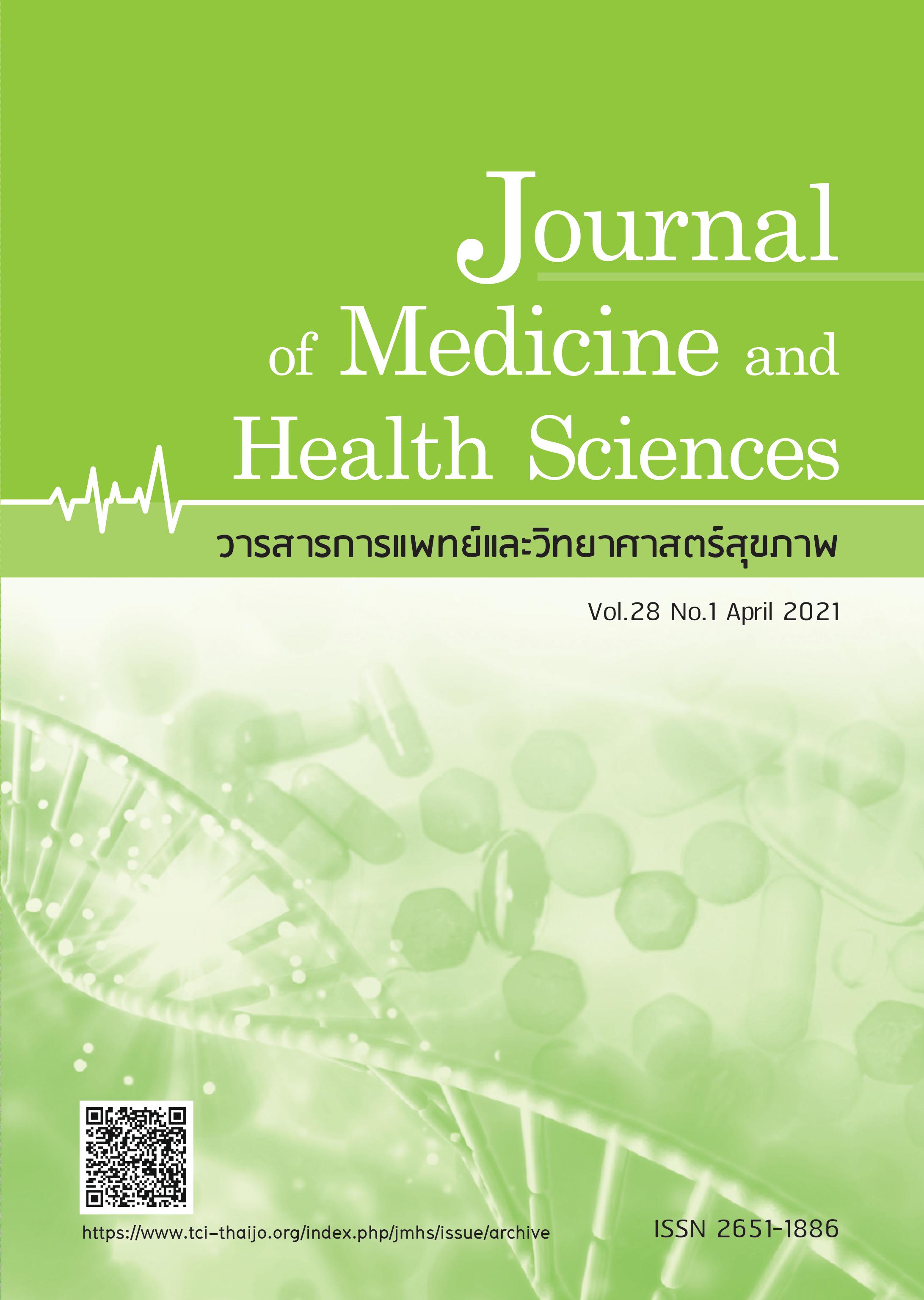Return to work among patients hospitalized with acute coronary syndrome at Nopparat Rajathanee Hospital
Keywords:
return to work, fitness for work, acute coronary syndrome, Occupational medicineAbstract
The objective of this study was to determine the rate of return to work among patients hospitalized with acute coronary syndrome at Nopparat Rajathanee Hospital and the factors associated with returning to work. The study design was a retrospective cohort study. The study samples were 125 patients, aged 18-60, with acute coronary syndrome and hospitalized in Nopparat Rajathanee Hospital from January 1, 2016 to December 31, 2018. The data on return to work and other factors were collected from the medical record data and telephone interviews. A survival analysis and a Cox proportional hazard model were used for data analysis. The participants consisted of 125 patients (100 male, 25 female), and the total follow-up time was 5414 person-days. The rate of return to work was 1.4 per 100 person-days (95%CI=1.20-1.86) and the median survival time of return to work was 30 days (95%CI=15-45). The rates of return to work in acute coronary syndrome in 30, 60, and 90 days were 56.8% 62.4% and 64.8%, respectively. After adjustment, the results indicated that females had a higher rate of decreased return to work (HRadj.=0.48; 95%CI= 0.24-0.96; p-value=0.04) as females were 52% less likely to return to work than males, while males were less likely to return to work at a rate of 2.1 times higher than females. In conclusion, the median survival time of return to work in patients with acute coronary syndrome and hospitalized in Nopparat Rajathanee Hospital was 30 days. Most returned to work in the same week and a small number returned to work, but modified or changed their work. Females were associated with lower likelihood of returning to work. Therefore, return to work assessment should be concerned with an early return to work suitably, safely and as soon as possible.
References
2. Department of disease control, Ministry of public health. Situation and conceptual framework [Internet]. [cited 2019 Sep 29]. Available from: https://bit.ly/3cJA6u0.
3. WHO Health Organization. Cardiovascular diseases (CVDs) [Internet]. 2017 [cited 2019 Sep 29]. Available from: https:// www.who.int/news-room/fact-sheets/ detail/cardiovascular-diseases-(cvds).
4. Division of non communicable diseases, Department of disease control. Campaign of world heart day 2018 [Internet]. 2018 [cited 2019 Sep 29]. Available from: https://bit.ly/2Y4ETlS.
5. Canadian Medical Association [Internet].Ottawa, ON: Author. 2001- . The physician’s role in helping patients return to work after an illness or injury (update 2000)
[cited 2019 Sep 29]. Available from: https://www.wcb.ns.ca/Portals/wcb/ Publications/Physicians_Role_in_RTW.pdf.
6. Ekpanyaskul C. Medical management after sickness In Principle of Occupational medicine for Preventive medicine &Public health. Bangkok: Jaransanitwong printing, 2018. p 139-172.
7. Sitthisook S. Guideline for primary care in acute coronary syndrome Guideline for treatment in acute coronary syndrome in Thailand 2014. Bangkok: Sri Mueang
Printing; 2014. p. 15-6.
8. Tungsubutra W. Non ST-segment elevation acute coronary syndrome. In: Maneerattanaporn M, editor. Survival guide in Acute care medicine 1. Bangkok: Printable; 2017. p. 120.
9. Ministry of Labour, Thailand. Ministerial regulation establishing standards for the management and operation of occupational health and safety and Work environment regarding heat, light and noise 2006 [Internet]. [cited 2019 Sep 29]. Available from: http://legal. labour.go.th/2018/images/law/Safety 2554/2/s_004.pdf.
10. Ministry of Labour, Thailand. Notification of the Ministry of Labour regarding the payment compensation period, rules and methods for calculating monthly wages
[Internet]. [cited 2020 Jan 14]. Available from: http://www.ratchakitcha.soc.go.th/ DATA/PDF/2562/E/067/T_0017.PDF.
11. Stendardo M, Bonci M, Casillo V, et al. Predicting return to work after acute myocardial infarction: Socio-occupational factors overcome clinical conditions.PLoS One 2018;13:e0208842.
12. Attarchi M, Amiri A, Mirzamohammadi E, et al. Assessment of the main factors influencing return to work following myocardial infarction: A longitudinal study. IJCRIMPH 2012;4:1305-14.
13. Slebus FG, Jorstad HT, Peters RJ, et al. Return to Work after an Acute Coronary Syndrome: Patients' Perspective. Saf Health Work 2012;3:117-22.
14. Ministry of Labour, Thailand. In case of requesting cash benefit [Internet]. [cited 29 Sep 2019]. Available from: https://bit. ly/3aKUKc8.
15. Jiang Z, Dreyer RP, Spertus JA, et al. Factors associated with return to work after acute myocardial infarction in China. JAMA Netw Open 2018;2:e184831.
16. Dreyer RP, Xu X, Zhang W, et al. Return to work after acute myocardial infarction: comparison between young women and men. Circ Cardiovasc Qual Outcomes 2016;9(2 suppl 1):S45-S52.
17. National Statistical Office Thailand. Female in working in Thailand 2017 [Internet]. 2018 [cited 2020 Apr 1]. Available from: https://bit.ly/358ZW89.
18. Jarachvarawat C. Risk factors and prevention of coronary artery disease. J Med Health Sci 2009;16:33-41. (in Thai).
19. Kanjanavanit R, Phrommintikul A. Comprehensive heart failure management program [Internet]. Bangkok: Concept medical; 2015 [cited 2020 Apr 1]. Available from: http://www.thaiheart.org/images/column_1291454908/ CMU%20HF%20Clinic.pdf.
20. Anne E, Michael C. Return to work after developing coronary heart disease, in: Keith T, Brown I, Hobson J. Fitness for work the medical aspects. fifth edition. Great Britain: Ashford Colour Press Ltd, Gosport, Hampshire; 2013. p.351-5.
21. Waszkowska M, Szymczak W. Return to work after myocardial infarction: a retrospective study. Int J Occup Med Environ Health 2009;22:373-81.



